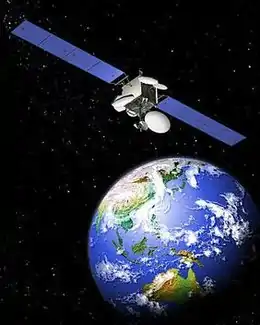MEASAT-3
MEASAT-3 is a Malaysian communications satellite which was successfully launched on 11 December 2006 from the Baikonur Cosmodrome in Kazakhstan.[1]
 Artist's impression of MEASAT-3 orbiting over Malaysia | |
| Mission type | Communications |
|---|---|
| Operator | MEASAT |
| COSPAR ID | 2006-056A |
| SATCAT no. | 29648 |
| Mission duration | 15 years |
| Spacecraft properties | |
| Bus | BSS-601 |
| Manufacturer | Boeing |
| Launch mass | 4,765 kilograms (10,505 lb) |
| BOL mass | 3,220 kilograms (7,100 lb) |
| Start of mission | |
| Launch date | 11 December 2006, 23:28:43 UTC |
| Rocket | Proton-M/Briz-M |
| Launch site | Baikonur 200/39 |
| Contractor | International Launch Services |
| Orbital parameters | |
| Reference system | Geocentric |
| Regime | Geostationary |
| Longitude | 91.5° east |
| Perigee altitude | 35,787 kilometres (22,237 mi) |
| Apogee altitude | 35,796 kilometres (22,243 mi) |
| Inclination | 0.05 degrees |
| Period | 23.93 hours |
| Epoch | 28 October 2013, 21:08:19 UTC |
| Transponders | |
| Band | 24 C-band 24 Ku-band |
In March 2003, MEASAT Satellite Systems Sdn. Bhd. of Malaysia ordered a Boeing 601HP satellite, giving it the designation MEASAT-3 at that time. MEASAT-3 joined the existing Boeing-built MEASAT-1 and MEASAT-2 spacecraft in the Malaysia-East Asia Satellite (MEASAT) system.
International Launch Services (ILS) was contracted as the launch provider. Boeing was specified to also provide an upgrade to the MEASAT ground facilities in Malaysia, as well as training and launch support services.
MEASAT-3 was by International Launch Services using a Proton-M rocket with a Briz-M upper stage. The upper stage made five burns to place MEASAT-3 into a geostationary transfer orbit. After circularisation and testing, the satellite entered commercial service on January 25, 2007, in geostationary orbit at a longitude of 91.5 degrees East where it is co-located with MEASAT-1. The C band and Ku band now covers geographically remote areas such as Sabah, Sarawak, and North India and expands the MEASAT fleet's coverage to more than 100 countries embracing Australia, Middle East, Eastern Europe and Africa.
Transponders
| EIRP (dBW) | 41 (Global beam), 45 (Asia beam) |
| G/T (dB/K) | +0.5 (Global beam), +2.8 (Asia beam) |
| TWTA power | 65 Watts |
| Transponder bandwidth | 24x36 MHz |
| Channel polarization | Linear |
| Frequency band | Uplink: 5,925-6,725 MHz Downlink: 3,400-4,200 MHz |
| EIRP (dBW) | 57 (Maximum) |
| G/T (dB/K) | +14 (Maximum) |
| TWTA power | 120 Watts |
| Transponder bandwidth | 24x36 MHz |
| Channel polarization | Linear |
| Frequency band | Uplink: 13.75-14.5 GHz Downlink: 10.95-12.75 GHz |
References
- "Proton M/Breeze M-MEASAT-3". International Launch Services. Archived from the original on 2009-02-15. Retrieved 2009-07-02.